Usnea
USNEA is not an international committee created by the United Nations. It’s a likable lichen. In fact all but two of the 20,000 or so lichen are forager friendly, if you prepare them correctly. Of the bunch, Usnea gets the Miss Congeniality Award, or the Most Likely to Succeed.
First, Usnea (OOS-nay-ah) is relatively low in acid (7% tops) and in small amounts can be eaten as is without soaking, and I have a tender tummy so it is quite compatible. Next, it is mostly carbohydrates, often 96%. It’s nearly all food and high in Vitamin C. Everyone from Native Americans to Europeans to the Chinese used it to dress wounds. What more could you ask for? Here in central Florida it is seen most often on oak trees, but in other areas it can be found on conifers as well as hickory, walnut, apple, mulberry, and golden rain trees. Recently I found some on sumac. Here it is one or two inches long, farther north it can be four or five inches long or more.
All lichen, including Usnea, should be soaked in several changes of water if one is going to eat more than a small amount of it. The leaching reduces the acid level and bitterness. Still, for legal purposes, everything comes with a warning these days. This lichen has been promoted for weight loss via an increase in the metabolism rate. There is no research on the safety or efficacy of eating Usnea for weight loss. I know I like it right off the tree in amounts about one/third to one half the size of a cotton ball, eating it as an occasional trail-side nibble. Larger amounts should be leached of the acid or it will irritate your lower digestive track. Individual results can vary, try cautiously. Some times it is sweet off the tree, some times bitter. Of the weight loss claims I know nothing.
Usnea is not hard to identify if one makes sure to look for specific markers. First it resembles hair, round, and is known as “Old Man’s Beard” and “Beard Lichen.” Technically it is a fruticose lichen, or a hanging hair lichen. It also resembles Spanish Moss, which was named after Usnea because Spanish Moss looks like it. Here is the big difference between the two:
Usnea has a white, elastic core going though its main trunk. If you gently pull it apart you will see a white core, it might even stretch. Spanish Moss has a black core. In fact, to my knowledge Usnea is the only lichen with a white core. Also most Usnea is gray green and does not change color through the season (there are exceptions. There is a red Usnea but also usable.) The point is, always pull apart the largest piece you can find and check for a very clear, very definite, white core.
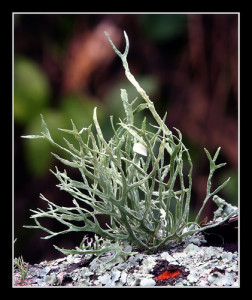
Florida Ramalina, photo by Michael Drummond
Another lichen Usnea gets confused with is Ramalina, which also grows locally and often in profusion. From a distance they can look the same. However, Ramalina like Usnea attaches with one point but its branches are flat, Usnea is round. It’s branches do not look hairy, Usnea looks hairy. And as mentioned, Ramina does not have a stretchy, white inner core. When you pull on a piece of Ramalina apart it breaks. Usnea usually stretches though old and dry Usnea can break but you will still see a white core.
The value of Usnea cannot be understated. For external wounds is can be a lifesaver to prevent infections and gangrene. Internally it is a pain reliever, broad spectrum antibiotic and works well against all gram-positive and tuberculosis species of bacteria (which reminds me … the roots of the Caesar Weed, a totally different plant, are good against gram-positive and gram-negative bacteria.) In modern times Usnea has been used to make skin creams, vaginal insertions, douches, and mouthwashes. Because it is also absorbent it has been used for diaper material and menstrual applications. It has been credited with stopping by decoction gangrene. When used externally or put in a tincture it turns rust-colored.
How many species of Usnea there are is anybody’s guess. There are at least several hundred though the number keeps changing. All you really need to know is how to identify your local Usnea. Usnea is Latin for the Arabic word ushnah, meaning ‘moss’. How Usnea is said is a bit of debate: OOS-nay-ah or oos-NAY-ah are common as is US-nay-ah. Which ever way you say it is not important: Just make sure you have the right plant.
It is usually said there are only two known toxic lichen out of 20,000, but no one knows for sure. One of those two is like a florescent lime-yellow green beard (no white core) and the other powdery, wrinkled yellow. In fact, you should avoid any lichen that is yellow or has yellow parts. That’s vulpinic acid best avoided. Also, while lichen have a lot of carbohydrates, the availability of it varies from lichen to lichen.
And in the “for what it’s worth department” Usnea is excellent bait for deer. And if you are in northern climates, really northern climates, lichen and human urine are even better deer bait. Apparently the deer in the frozen north crave salt and can detect it in human urine.
Green Deane’s “Itemized” Plant Profile
IDENTIFICATION: Resembles tuffs of hair or a beard, short or long, gray/green though some species yellowish or red. Has unmistakable white core when main stem is pulled apart.
TIME OF YEAR: Year round around the world.
ENVIRONMENT: Everywhere but prefers some moisture as well as growing on hardwood trees, conifers, and fruitwoods. Very sensitive to sulfuric acid and won’t grow in polluted areas.
METHOD OF PREPARATION: Small mounts raw, larger amounts need to be soaked in changes of water to remove acid, or with bicarbonate of soda or hardwood ashes. Externally, simply applied to a wound. Soaking water can be used for irrigation and rinsing.
HERB BLURB
As for internal applications herbalist say one can make a tea or better still a tincture ahead of time. Collect it and cover with vodka. To read a study on usnea as an antibiotic click here.

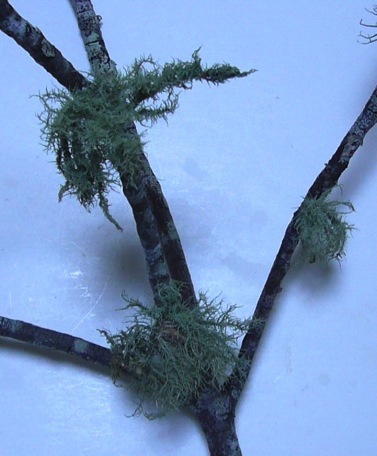
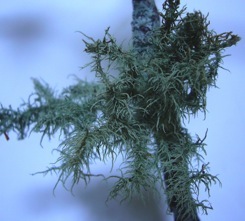
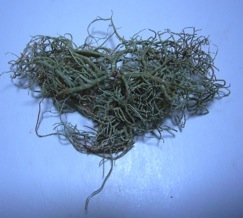

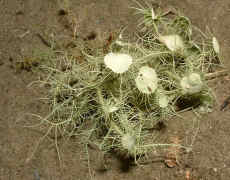
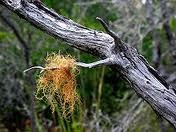

Hi! First… thanks for all the wonderful info you give us. It’s really appreciated! I went to click on the link about Usnea as an antibiotic but it came back as a bad request? Hope you can fix? Thanks again and have a great Thanksgiving.
The link appears to be working. Where I did make a mistake was in the mailing program newsletter title. I can’t change the mailing program now. They changing it for worse with “improvements” that makes it easier to make mistakes.
Apparently they changed the site. I have updated the link.
Love the site! Thanks for the great info. I have a tract of land that is abundant w/ Usnea. I gather daily what has fallen off the trees. Is there any place i could sell it to?? What about preserving it? I save some in brown paper bags and tincture it too. Thanks for your time, Jan
What eats it??
Wonderful information!
Really thanks!
I just didn’t understand two moments.
1) Is it possible to prepare Usnea for eating just to soak in the water without the lye or soda? I understand it is recommended to use the lye or soda. Is it really necessary or it is possible to avoid it soaking more days in usual water for (regular eating)?
2) In one place you recommend to avoid yellow lichens. In other sentence you were saying, Usnea may be less or more yellow too.
So, if Usnea will have yellow color, is it possible to eat it or it is right to avoid it?
You don’t need lye. Just change the water a couple of times a day for a few days. The lichen I was referring to is really yellow. Usnea can sometimes have a bit of a yellow cast but is not bright yellow.